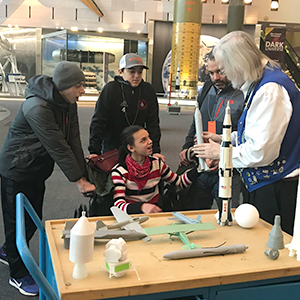Eight years ago, the Smithsonian piloted Morning at the Museum, a free
weekend morning program for young people on the autism spectrum, ages 5-12.
That first year, there were more volunteers than participants. Today, the
program – which has expanded to include youth, as well as teens with
autism, intellectual disabilities, sensory processing disorders and other
cognitive disabilities – attracts hundreds of young people and their
families. Smithsonian museums and the National Zoo have wholeheartedly
embraced the program, which is offered throughout the year. Fall programs
are planned at the National Museum of African Art (Sept. 8), National
Museum of Natural History (Sept. 14), Udvar Hazy Center (Sept. 28),
National Museum of the American Indian (Oct. 19), National Museum of
American History (Oct. 26), Arthur M. Sackler Gallery (Nov. 3), National
Zoo (Nov. 17) and Anacostia Community Museum (Dec. 7). A waiting list
reflects the growing demand for such programs.
“Our hope is that participants grow more comfortable at the Smithsonian,
are able to visit other museums – either with their families or with their
schools – and that they see museums as accessible and welcoming places,”
says Ashley Grady, senior program specialist with Access Smithsonian, the
office that organizes Morning at the Museum. “Ultimately, we hope our
participants become lifelong museums goers.”
Morning at the Museum offers children and their adult companions early
museum entry on select Saturday or Sunday mornings, with sensory-friendly
activities to minimize unexpected stimuli and create a more enjoyable
museum experience. Because the programs begin before regular hours,
families avoid long lines and crowds, are better able to determine which
galleries might be too loud or too bright and can navigate the museum at
their own pace. Lights are dimmed in some exhibitions; in others, the sound
is turned down or off.
In the past, Lynda Kwon didn’t take her 11-year-old daughter to museums.
Charlotte, who is on the spectrum, doesn’t do well in crowds and is
especially fearful of the noise made by hand dryers typically found in
public restrooms. During Morning at the Museum, however, paper towels
replace dryers. “It may seem like a small gesture, but that extra step
means everything to my daughter,” says Lynda.
Yetta Myrick, who grew up going to the Smithsonian, has always wanted to
share that experience with her son. Morning at the Museum made that
possible for 15-year-old Aidan, who is on the spectrum and gets easily
over-stimulated by noises and crowds. Yet, at a recent visit to the
National Zoo, instead of putting his fingers in his ears, he was able to
enjoy a ride on the carousel since the lights and music were turned off
during the early morning program.
For 16-year-old Patxi Uy, who has Down’s Syndrome, Morning at the Museum
has grown not only his enjoyment of museums, but his interest in science.
“It’s become a true passion,” says his mother, Monica, adding that Patxi
recently completed an internship at the National Museum of Natural History.
The Access Smithsonian staff “has a great understanding of what works with
different audiences,” adds Monica. For instance, designated “take a break”
spaces – empty classrooms or quiet galleries – feature sensory calming toys
and materials to help kids work out their energy.
Pre-visit materials also help families plan for new experiences, such as
going through security and how to take turns at museum interactives.
Families are informed about everything from temperature (museums can be
cold) to gallery closings (the National Air and Space Museum is currently
under renovation). “That kind of advance information can make for smoother
transitions,” says Ashley.
“I’ve heard people use the term ‘museum ready’ to describe children,” says
one regular participant, Laurelle Lo. “At Morning at the Museum, every
child is ‘museum ready.'” Her youngest child, Linden, who was adopted from
China, was born with hearing loss. Over the years he’s struggled with how
to filter out ambient noise. While he has since learned to adapt to the
hearing world, being in a calm environment that has limited ambient noise
with educators who understand the challenges facing kids with disabilities
has been a gift. His older brother has benefited as well, since the entire
family is welcome at the monthly programs.
A number of parents pointed out that there’s an unspoken camaraderie they
rarely feel in public settings. “There’s no judgment, weird looks or stares
from strangers,” says Lynda. If anything, when a child is having a
meltdown, another parent is likely to step in with a solution. “The Access
Smithsonian staff sets the tone, which is one of understanding, support,
patience and compassion,” she adds.
“Hosting Morning at the Museum, seeing how engaged these families are and
how I get to interact with them on a one-to-one basis reminds me of why I
got into this work in the first place,” says Gloria Kenyon, public program
coordinator at the Smithsonian American Art Museum.
“These are our most grateful visitors,” adds M. Karel Tiefel, department
coordinator for Public and Scholarly Engagement at the Freer Gallery of Art
and Arthur M. Sackler Gallery, which has hosted such activities as a matcha
tea ceremony and yoga.
Access Smithsonian staff take a holistic approach to accessibility and
inclusion in order to ensure that all visitors, including people with
disabilities, are able to benefit from and have access to what the
Smithsonian offers in its buildings, collections and programs. Morning at
the Museum is one of several signature programs.
For more information, contact Ashley Grady at access@si.edu or 202-633-2921.

